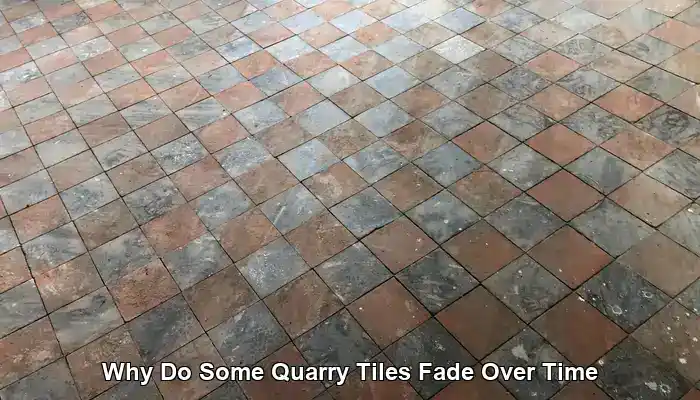
Quarry tiles are highly esteemed for their remarkable durability, earthy aesthetics, and timeless appeal. These dense, unglazed ceramic tiles are perfectly suited for various settings, whether adorning the floors of a rustic kitchen or creating an inviting atmosphere on a sunlit patio. Designed to withstand heavy foot traffic and harsh environmental conditions, they are a popular choice among homeowners and property managers. However, despite their solid reputation, many notice a gradual fading of colour over time, which can manifest as uneven and stark changes. It can be perplexing to observe these tiles, once vibrant with rich shades of reds, warm browns, or deep terracotta, transitioning to a pale, patchy, or dull appearance.
The fading of quarry tiles extends beyond mere aesthetics; it often signals deeper issues related to wear and tear, environmental stressors, or chemical damage. Outdoors, these tiles face relentless exposure to the elements—such as rain, frost, and extreme temperature changes—that progressively damage their surface. The freeze-thaw cycle, in particular, can inflict micro-cracks and surface spalling, unveiling lighter inner layers with coarser textures. Indoors, the challenges differ but remain significant. High foot traffic gradually wears down the tile’s pigmented surface, revealing the inner body, often composed of larger particles and varied mineral hues. This natural stratification means that once the surface is compromised, both the colour and texture can alter dramatically, resulting in an undesirable appearance.
In addition to physical wear, the exposure to harsh chemicals markedly accelerates the fading process. Aggressive cleaning agents, especially those that are acidic or alkaline, can damage sealers and erode protective coatings. Over time, such degradation leaves the tile vulnerable to staining, efflorescence (the formation of salt deposits that lighten the surface), and the build-up of dirt in newly formed pits and abrasions. These combined factors contribute to a faded, uneven appearance, detracting from the tile’s inherent beauty and charm.
Gaining an understanding of the reasons behind the fading of quarry tiles is an essential first step in preserving their unique character and extending their lifespan. This comprehensive article will explore the environmental, mechanical, and chemical factors that lead to fading—both indoors and outdoors—while offering practical tips for prevention and restoration. Whether you are caring for a historic floor or simply want to maintain your tiles in pristine condition, this guide will help you grasp the intricate science behind quarry tile wear.
Essential Expert Tips for Maintaining Your Quarry Tiles Effectively

Fila Pro Floor Cleaner
|

LTP Floorshine
|

Vileda H2PrO Spin Mop System
|
Exploring Key Outdoor Environmental Factors That Lead to Quarry Tile Fading
Quarry tiles installed outdoors are continuously exposed to a relentless barrage of environmental stressors that gradually erode their colour and texture. While these tiles are celebrated for their remarkable strength, nature possesses a remarkable ability to wear down even the most resilient surfaces over time. Understanding these factors is essential for proper care and maintenance.
How Does Weather Impact the Appearance of Quarry Tiles?
Among the most significant contributors to fading is the weather, particularly rain and the freeze-thaw cycle. Rainwater can permeate the porous surface of unsealed or inadequately sealed tiles, transporting minerals and contaminants that can stain or leach colour from the tiles. When temperatures plummet, the moisture trapped within the tile expands upon freezing, leading to micro-cracks and surface flaking. This ongoing cycle not only compromises the tiles’ integrity but also exposes the lighter inner body of the tiles, which frequently consists of less pigmented materials, resulting in a duller overall appearance.
What Role Does Surface Wear and Layer Exposure Play in Outdoor Settings?
Quarry tiles typically feature a dense outer crust that retains the most vibrant colours. However, as this outer layer wears away due to foot traffic, abrasion, or natural erosion, the underlying layer becomes increasingly visible. This inner layer is often rougher and contains larger aggregate particles, which can present a lighter, uneven hue. The result is a patchy appearance that lacks the original richness and vibrancy that these tiles are known for, significantly detracting from their aesthetic appeal.
How Can Chemical Damage from Outdoor Cleaning Agents Impact Quarry Tiles?
Outdoor cleaning routines frequently involve the use of powerful chemicals aimed at combating moss, algae, or stubborn grime. Unfortunately, these harsh solutions can degrade sealers and strip away protective coatings. Once the sealer is compromised, the tile becomes increasingly susceptible to staining, mineral deposits, and accelerated wear. Over time, this chemical exposure can significantly contribute to the fading and dullness of the tile surface, making careful product selection crucial.
Investigating Indoor Factors That Contribute to Quarry Tile Fading

While outdoor quarry tiles grapple with harsh environmental elements, indoor tiles encounter a distinct set of challenges that can also lead to fading over time. From everyday foot traffic to cleaning routines, the fading of indoor quarry tiles is often a slow and cumulative process driven by wear, surface degradation, and chemical exposure.
What Is the Impact of Abrasive Wear and Surface Crust Loss?
Quarry tiles are designed with a dense, pigmented outer crust that provides their rich colour and smooth finish. Indoors, especially in high-traffic areas such as kitchens, hallways, and commercial spaces, this outer crust gradually diminishes. As the surface erodes, the inner body of the tile becomes more exposed, revealing a layer that typically contains larger mineral particles and is more porous, resulting in a noticeable shift in both colour and texture. Earth-toned tiles may start to appear mottled or washed out, with lighter patches developing where the crust has worn thin, thus diminishing their overall appeal and charm.
How Does Surface Pitting and Soil Accumulation Influence Indoor Environments?
With the wearing down of indoor quarry tiles, micro-abrasions and pits begin to form. These tiny indentations act as reservoirs for soil, grease, and cleaning residues. Over time, the accumulation of grime in these micro-pits can create uneven staining and dullness. Even regular cleaning efforts may not effectively remove embedded dirt, leading to a faded and blotchy appearance. This issue is particularly prevalent in older floors that have not been adequately sealed or maintained, further exacerbating the fading process and its impact on aesthetics.
What Is the Role of Efflorescence and Mineral Migration in Tile Fading?
Efflorescence represents another significant factor contributing to indoor tile fading. This phenomenon occurs when moisture trapped beneath the tile migrates upwards, carrying soluble salts to the surface. As the moisture evaporates, it leaves behind a white, powdery residue that lightens the tile’s appearance and can cause surface damage. Efflorescence is particularly common in areas lacking proper subfloor ventilation or where tiles are installed over damp concrete. If left unaddressed, this condition can degrade the tile’s surface further and complicate cleaning efforts, necessitating careful management.
How Does Chemical Overuse and Sealant Breakdown Affect Tile Fading?
Indoor cleaning routines often rely on strong chemical agents, especially in commercial or food preparation areas. While these products can be highly effective at removing grease and stains, they can also strip away sealers and protective coatings. Once the sealer is compromised, the tile becomes more porous and vulnerable to staining, wear, and further fading. Acidic or alkaline cleaners may etch the surface, permanently altering its texture and colour. Over time, the repeated exposure to harsh chemicals accelerates the deterioration of both the tile and its finish, making careful selection and usage essential.
What Essential Maintenance Practices Should Be Followed for Quarry Tiles?
The fading of indoor quarry tiles is often preventable with appropriate care and maintenance. Employing pH-neutral cleaners, adhering to a regular sealing schedule, and avoiding abrasive cleaning tools can significantly extend the life and aesthetic appeal of the tiles. For older floors exhibiting signs of wear, professional restoration—including deep cleaning, re-sealing, and colour enhancement—can help restore their original beauty and charm, ensuring they continue to enhance the space.
Implementing Effective Strategies for Preventing and Restoring Quarry Tiles

Understanding the reasons behind the fading of quarry tiles is just one part of the equation—the true value lies in knowing how to prevent fading and restore their original charm when wear inevitably occurs. Regardless of whether your tiles are situated indoors or outdoors, proactive maintenance and thoughtful restoration can significantly extend their lifespan while preserving their rich, earthy character and aesthetic appeal.
Why Is Sealing the Primary Defence Against Fading?
One of the most effective strategies for preventing fading is through proper sealing. Quarry tiles are inherently porous, and without a protective barrier, they readily absorb moisture, dirt, and harmful chemicals. A high-quality penetrating sealer fills the pores without forming a surface film, allowing the tile to breathe while repelling contaminants. For outdoor tiles, this is crucial to protect against rain, frost, and algae growth, which can exacerbate fading. Indoors, sealing helps resist staining from spills, cleaning products, and heavy foot traffic that can wear down the surface.
Sealers should be reapplied periodically—typically every 1 to 3 years, depending on usage and exposure conditions. A simple water-drop test can help determine when resealing is necessary: if water seeps in rather than beads on the surface, it’s a clear indication that it’s time for a refresh to maintain optimal protection.
What Smart Cleaning Practices Should Be Followed to Avoid Harsh Chemicals?
Routine cleaning is vital, but the choice of products for this task is of utmost importance. Harsh chemicals, especially those with acidic or alkaline properties, can degrade sealers and etch the tile surface. Over time, this deterioration can lead to dullness, discoloration, and increased susceptibility to staining. Instead, opt for pH-neutral cleaners specifically formulated for stone or tile surfaces. These cleaning agents effectively lift dirt without compromising the integrity of the tile, ensuring they remain beautiful and well-maintained.
For stubborn grime or efflorescence, use targeted treatments sparingly and always follow up with a thorough rinse. Avoid bleach, ammonia, and vinegar-based solutions, which may initially seem effective but can result in long-term damage and fading of the tile surface.
What Maintenance Techniques Can Help Preserve Tile Colour?
Regular sweeping and damp mopping are essential practices to prevent soil buildup and surface abrasion. Utilize soft-bristle brushes or microfiber pads instead of abrasive scrubbers, which can inadvertently wear down the tile’s pigmented surface. In high-traffic areas, consider placing rugs or mats to minimise direct wear—especially near entryways or kitchens where foot traffic is heaviest.
For outdoor tiles, pressure washing should be approached with caution. While it can effectively remove surface dirt, excessive pressure may erode the tile or force water into cracks, exacerbating freeze-thaw damage. If pressure washing is necessary, ensure the pressure is kept low and the nozzle is held at a safe distance to avoid causing harm.
How Can Professional Restoration Revive Quarry Tiles?
When fading becomes evident and routine care proves insufficient, professional restoration can yield remarkable results that revive the tiles’ original beauty. Restoration specialists utilise a combination of deep cleaning, mechanical resurfacing, and colour enhancement techniques to rejuvenate worn tiles.
- Deep cleaning effectively eliminates embedded dirt, grease, and mineral deposits through the use of specialized equipment and solutions.
- Mechanical honing or polishing restores smoothness to worn surfaces and enhances texture, particularly for indoor tiles displaying surface pitting.
- Colour enhancement sealers can enrich faded hues, especially in earth-toned tiles, by deepening natural pigments without imparting a glossy finish, helping to restore their original vibrancy.
In cases of severe wear, restoration may also necessitate regrouting, tile replacement, or the application of protective coatings tailored to the specific environment of the tiles, ensuring long-lasting results.
What Is the Importance of Developing a Long-Term Care Strategy?
Preventing future fading requires a long-term approach. Establish a maintenance schedule that incorporates regular inspections, comprehensive cleaning, and resealing. Educate household members or staff on proper cleaning techniques and the significance of using suitable products specifically designed for quarry tiles. For commercial spaces, consider collaborating with a floor care professional to devise a customized plan based on traffic levels and environmental conditions.
If your tiles are part of a heritage property or possess historical significance, it is advisable to consult with conservation experts before initiating any restoration efforts. Preserving the authenticity of older quarry tiles often necessitates specialized techniques and materials, ensuring their historical integrity remains intact.
Insights and Answers to Common Queries About Quarry Tile Care
Is it possible to effectively restore faded quarry tiles?
Indeed, quarry tiles can often be rejuvenated through deep cleaning, resealing, or even professional refinishing techniques, depending on the extent of the fading. Homeowners should explore their options for reviving the beauty and vibrancy of their tiles.
How frequently should quarry tiles be cleaned?
Regular sweeping should be conducted weekly, with more thorough cleaning every few months to maintain their appearance and prevent fading. Establishing a consistent cleaning routine will help protect their vibrancy and extend their lifespan.
Are there specific sealants designed for quarry tiles?
Yes, there are specialized sealants formulated specifically for quarry tiles that provide protection against moisture and UV rays, enhancing their longevity and aesthetic appeal. Homeowners should consult professionals for tailored recommendations based on their specific tile types and conditions.
Which cleaning products should be avoided on quarry tiles?
Avoid using acidic cleaners, harsh chemicals, and abrasive scrubbers, as these can damage the surface and contribute to fading. Instead, opt for gentle, tile-safe products that maintain the integrity of the tile while ensuring cleanliness.
How can I determine if my quarry tiles require resealing?
If water no longer beads on the surface or the tiles appear dull and stained, it may be time to reseal. Regular checks can help maintain optimal protection and appearance, ensuring the tiles remain vibrant.
Does indoor lighting influence the fading of tiles?
Indirect indoor lighting generally exerts less effect than UV rays, but prolonged exposure to bright light can contribute to gradual fading. Homeowners should consider their lighting options and placement when designing spaces to minimise potential fading.
Can I use a steam cleaner on quarry tiles?
Steam cleaners may be too harsh for quarry tiles, potentially damaging their surface. It is advisable to adhere to recommended cleaning methods to maintain their integrity and appearance over time.
Are certain quarry tiles more susceptible to fading than others?
Yes, tiles made from inferior materials or pigments may fade more quickly compared to those crafted from high-quality materials. Homeowners should prioritise quality in their tile selections to ensure longevity and aesthetic durability.
Does foot traffic significantly affect the lifespan of quarry tiles?
High foot traffic can lead to accelerated wear and tear, increasing the occurrence of fading and the need for maintenance. Homeowners should implement strategies to effectively manage foot traffic on their tiles, preserving their beauty and integrity.
Is it entirely possible to prevent fading in quarry tiles?
While completely preventing fading can be challenging, regular maintenance, proper sealing, and the careful selection of quality products can significantly reduce colour loss over time, helping to maintain the tiles’ original charm.
The article Why Do Some Quarry Tiles Fade Over Time: A Guide was first found on https://www.abbeyfloorcare.co.uk
The Article Quarry Tiles Fade: Understanding the Causes and Solutions appeared first on https://fabritec.org
The Article Quarry Tiles Fade: Causes and Solutions Explained Was Found On https://limitsofstrategy.com



